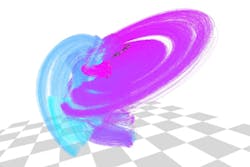Carnegie Mellon technique reconstructs 3D motion from hundreds of video feeds
IMAGE: CMU researchers can combine hundreds of video camera views to perform large-scale 3D motion reconstruction including the swirl of air currents and even a cascade of confetti.
Carnegie Mellon University (CMU; Pittsburgh, PA) researchers have developed techniques for combining the views of 480 video cameras mounted in a two-story geodesic dome to perform large-scale 3D motion reconstruction, including volleyball games, the swirl of air currents, and even a cascade of confetti.
RELATED ARTICLE: Variational image-stitching technique uses ground-state model
Though the research was performed in a specialized, heavily instrumented video laboratory, Yaser Sheikh, an assistant research professor of robotics who led the research team, said the techniques might eventually be applied to large-scale reconstructions of sporting events or performances captured by hundreds of cameras wielded by spectators. A video of the 3D reconstructions and links to the team's research paper are available on the project website at http://www.cs.cmu.edu/~hanbyulj/14/visibility.html.
In contrast to most previous work, which typically has involved just 10 to 20 video feeds, the Carnegie Mellon researchers didn't have to worry about filling in gaps in data; their camera system can track 100,000 points at a time. Rather, they have to figure out how to choose which of the hundreds of video trajectories can see each of those points and select only those camera views for the reconstruction.
"At some point, extra camera views just become noise,'" said Hanbyul Joo, a Ph.D. student in the Robotics Institute. "To fully leverage hundreds of cameras, we need to figure out which cameras can see each target point at any given time." The research team developed a technique for estimating visibility that uses motion as a cue. In contrast to motion capture systems that use balls or other markers, the researchers used established techniques for automatically identifying and tracking points based on appearance features--in this case, distinctive patterns. For each point, the system then seeks to determine which cameras see motion that is consistent with that point.
Other researchers have been able to use images from a large number of cameras, such as smartphones, to create 3D reconstructions of still images, Joo noted. But without methods such as the visibility estimation technique, 3D motion reconstruction at such a large scale has not been possible.
In their laboratory, called the Panoptic Studio, the researchers have 480 video cameras, plus an additional 30 high-definition video cameras, arrayed all around and halfway up the walls of a geodesic dome that can easily accommodate 10 people.
Such a dense array of cameras enables the researchers to perform 3D motion reconstructions not previously possible. These include 3D reconstructions of a person tossing confetti into the air, with each piece of paper tracked until it reaches the floor. In another case, confetti is fed into a fan, enabling a motion capture of the air flow. "You couldn't put markers on the paper without changing the flow," Joo explained.
The findings were presented at the Computer Vision and Pattern Recognition conference, June 24-27, in Columbus, OH.
SOURCE: Carnegie Mellon University; http://www.cmu.edu/news/stories/archives/2014/july/july17_reconstructing3Dmotion.html
